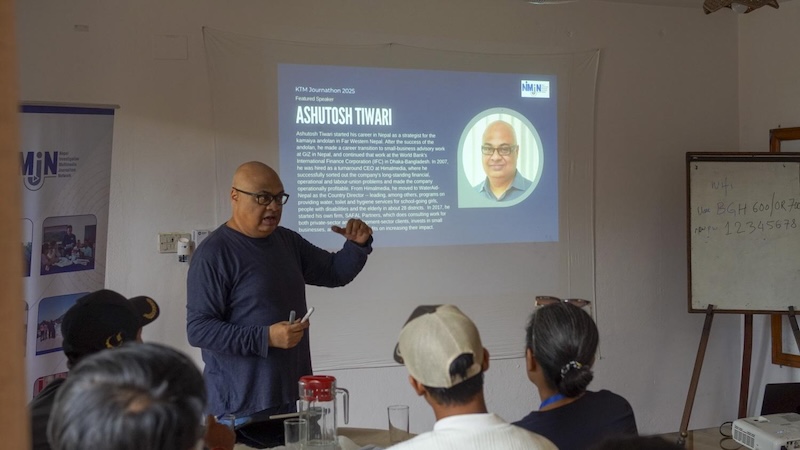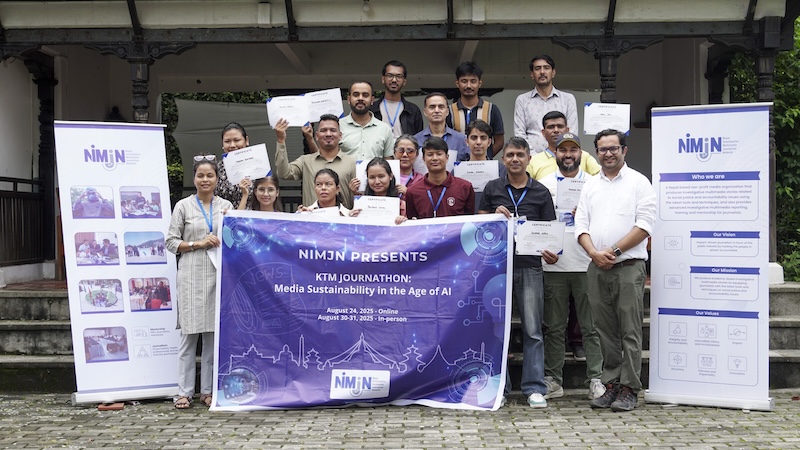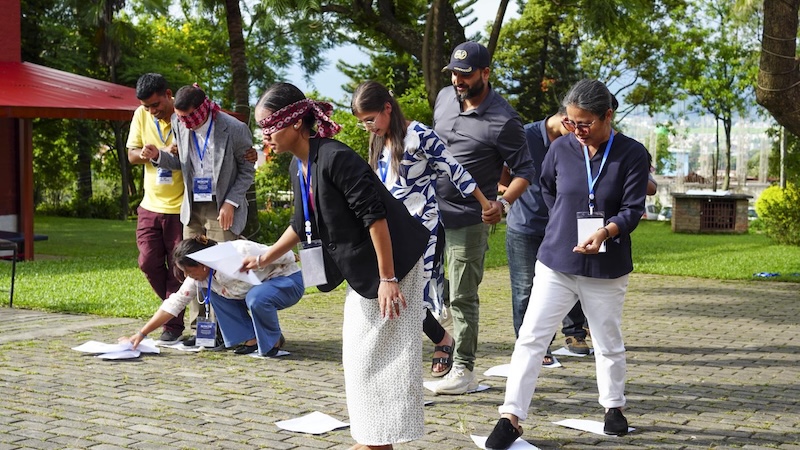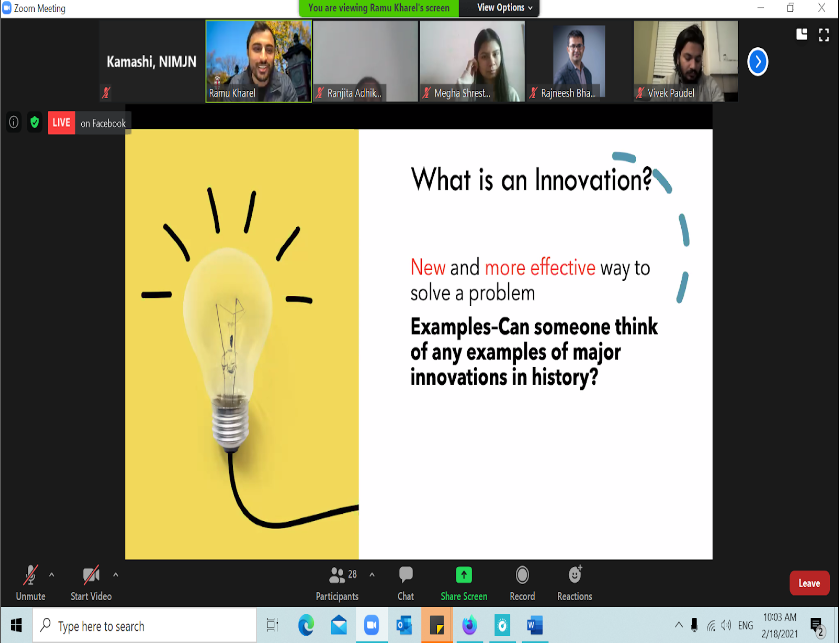NIMJN organized KTM Journathon 2025: Media Sustainability in the Age of AI on August 30–31 in Bhaktapur. The event brought together journalists, creators, activists, health and development professionals, and AI experts to discuss media challenges, opportunities, and integration strategies for media sustainability in the era of AI.

NIMJN’s Chief Editor, Rajneesh Bhandari, opened the session with an introduction to the design thinking model, highlighting the stages of empathizing and defining media sustainability issues. He emphasized the importance of understanding the problem with empathy and clearly explaining it before preparing prototypes. Participants then worked individually to identify and define their own problem statements.
The first day of the Journathon featured Ashutosh Tiwari, Founder of SAFAL Partners, who shared revenue models and strategies for media sustainability with AI, linking them to the design thinking process. He discussed transforming ideas into revenue models by leveraging AI.

Ashutosh emphasized that the knowledge industry is rapidly expanding and that information is the ‘fuel’ that must serve the public interest and uphold truth. He noted that blending AI and information is essential for maximizing their potential to sustain media and reducing and negotiating monthly burn rates.
Following his session, participants brainstormed and applied design thinking steps: empathize, define, and ideate to prepare prototypes. They discussed challenges and worked on empathizing and defining personas individually, focusing on issues such as non-Gen Z-friendly media content, misinformation and disinformation related to climate change and disasters, communication gaps between doctors and patients, and fact-checking viral content.
Guided by NIMJN mentors, participants formed four groups, identified shared issues, and developed prototype solutions, which they presented and refined based on peer feedback.
On the second day, participants continued to develop and revise their prototypes based on suggestions from other groups and mentors. After completing the final versions, they presented their prototypes. A summary of the presented prototypes (projects/products) is as follows:

Group 1 – Priyanka Hamal, Veneeta Singha, and Kul Prasad Ghimire (Rabindra)
A Remote Reality documentary site featuring raw videos, stories, and photos from remote Nepali regions like Karnali/Marpha. Proposed revenue models: ticketing, monetization, and cost-saving measures.
Group 2 – Arun Sah, Dinesh Regmi, and Binu Shrestha Nagarkoti
Wellness Tourism in Nepal (Gosaikund), promoting year-round tourism, rather than seasonal visits. Proposed revenue models: corporate partnerships, coaching programs, and memberships.
Group 3 – Rajendra Bhatta and Rakesh Nepali
Rumors vs. Fact-Checking through Data, where open data (on climate change, jobs, and economy) will be simplified and shared via TikTok and memes to make it Gen Z-friendly. Proposed revenue models: collaboration and coordination with government agencies, I/NGOs, and campaigns.
Group 4 – Suman Gyawali, Rinchen Tamang, Mariam Bhattarai, and Govinda Raj Nepal
Doshi Chasma, a web app with a chatbot and game to help users identify dis/misinformation related to disaster.
Proposed revenue models: collaborations with I/NGOs and government agencies.

Virtual Training for Participants
A half-day virtual training for participants was held on August 24, 2025. The discussion highlighted the use of the design thinking process to explore media sustainability issues and their solutions. The session featured insights from Mayank Agrawal of Reporter’s Collective, India, and Kamashi Pokharel Sharma of Kaplan Business School, Australia.

Mayank discussed the use of AI in journalism, outlining both its rewards and risks, while touching on the state of press freedom at regional and international levels. Drawing from his experience covering the environment, business, and climate change, he explained how environmental reporting often overlaps with diplomacy, politics, sports, business, and infrastructure, and journalists working on these issues feel “sandwiched”.
“Environmental reporters are under particular threat, with attacks rising sharply in the last five years,” Mayank said. “These realities show why media sustainability and safety are urgent issues.”
Mayank pointed out that Asian countries face constant pressure to prioritize profit-driven projects and large-scale infrastructure over sustainability. Many countries are replicating development models from other nations that have already borne heavy ecological costs. The session emphasized that rethinking these development models and supporting fearless journalism are crucial for the region’s future, as the lack of these hinders media sustainability in a significant way.

Adding another dimension to the discussion, Kamashi shared her insights on ethics and sustainability through the lens of design thinking. She emphasized that while technology plays a vital role, the future of media also depends on strong values, creativity, and life skills.
She introduced participants to the Stanford design thinking model, which includes five steps: empathize, define, ideate, prototype, and test. This framework encouraged participants to think innovatively and develop people-centered solutions for media sustainability challenges.
Kamashi also highlighted the concept of the 3Ps, People, Planet, and Profit, as guiding principles for building sustainable media practices. Through persona-building and iterative exercises, participants explored innovative ways to strengthen media engagement and reimagine journalism’s role in serving society. She explained each step of the design thinking process with practical examples, linking it to media sustainability and the use of AI.

Participants Feedback
“I always look for learning opportunities, whether paid or unpaid. I learned about this Journathon through Facebook, applied, and was fortunate to be selected. At first, when I entered, everyone seemed older and more experienced, and I wondered how I would adjust. However, once the discussion began, I found everyone to be extremely supportive and helpful. I learned a lot of new things and content. Thank you once again for this opportunity and the welcoming environment.” - Suresh Bam, Kalikot

“Having people with different backgrounds, experiences, and skills in one place, all working toward the same goal, was very interesting. What I learned in this Journathon is that collaboration and coordination are key to achieving the best results and creating a strong product. I believe this experience and learning will support me in other sectors and in my career in the future. I am grateful for this opportunity.” - Mariam Bhattarai, Kathmandu



